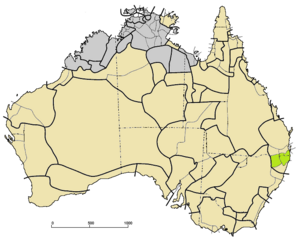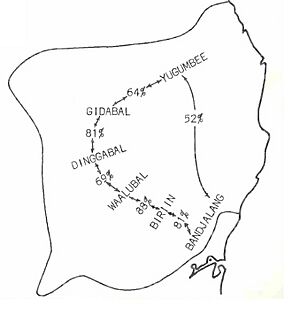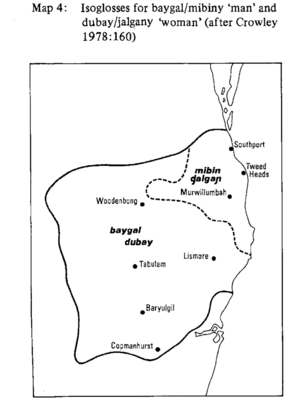Yugambeh–Bundjalung languages facts for kids
Quick facts for kids Yugambeh–Bandjalangic |
|
|---|---|
| Ethnicity: | Bundjalung people (Minyungbal, Widjabal), Western Bundjalung people, Githabul, Yugambeh people |
| Geographic distribution: |
Queensland & New South Wales, Australia |
| Linguistic classification: | Pama–Nyungan
|
| Subdivisions: |
Lower Richmond
|
 Bandjalangic languages (green) among other Pama–Nyungan (tan)
|
|
 |
|
| This article contains IPA phonetic symbols. Without the correct software, you may see question marks, boxes, or other symbols instead of Unicode characters. |
The Yugambeh–Bundjalung language group, also called Bandjalangic, is a family of languages. These languages are part of the larger Pama–Nyungan language family. They are spoken in the northeastern part of New South Wales and southeastern Queensland in Australia.
Historically, Yugambeh–Bundjalung was a group of many related ways of speaking, called dialects. These included Yugambeh, Nganduwal, Minjangbal, and others. The dialects were like a chain, where nearby ones were easy to understand. But dialects far apart were harder to understand. These dialects formed four main groups:
- Tweed-Albert Language (Yugambeh)
- Condamine-Upper Clarence (Githabul)
- Lower Richmond (Eastern Bundjalung)
- Middle Clarence (Western Bundjalung)
Sadly, almost all Yugambeh–Bundjalung languages are now close to disappearing. The Bandjalang proper dialect has the most speakers, with 113 people. Other dialects have very few speakers, totaling only 26 people.
Some other languages, like Gowar and Pimpama, might also be related to the Bandjalangic languages.
Contents
What's in a Name?
The Yugambeh-Bundjalung language group is used by many different cultural groups. Some of these groups prefer to use the name of their specific dialect, like Githabul or Yugambeh. This is because some groups don't see all the different ways of speaking as the "same language."
A doctor named W. E. Smythe studied the Bundjalung language in the 1940s. He thought he was writing a grammar for the whole language group. But he was actually just writing about the Casino dialect. He noticed that people were confused about the name for the whole language group. Some said the name should be 'Beigal' (meaning 'man' or 'people'). Others said there was no group name. Some thought 'Bandjalang' was a name for one local group and also for the whole language family. Smythe decided to use 'Bandjalang' for the whole group to make it easier.
It can be confusing because different groups use different names. What one group calls another might not be what that group calls itself. Also, the name of a dialect can change over time. For example, the Baryulgil dialect was first called Wehlubal, but later it was called Wirribi.
Early studies from the 1800s didn't give a single name for the whole language group. But writers knew these languages were connected. They often referred to them by local names. In the early 1900s, non-Indigenous groups started naming larger language groups. This sometimes meant local dialect names were lost. Because Yugambeh-Bundjalung is on the border of Queensland and New South Wales, two main names became common: Yugambeh on the Queensland side and Bundjalung on the New South Wales side. This is why Margaret Sharpe named the group Yugambeh-Bundjalung. These names are also for the most northern and southern dialects.
Today, many Yugambeh-Bundjalung speakers know and use the main terms Yugambeh and Bundjalung. Some groups use these names with their own local name, like Byron Bay Bundjalung – Arakwal. However, since these words also refer to single dialects, some groups don't like using them for the whole family. Experts agree that Yugambeh was originally the Beaudesert dialect. Bundjalung first referred to the Bungawalbin Creek/Coraki dialect. But the Tabulam people say they are the original Bundjalung. They use Bandjalang to show this difference.
Where is it Spoken?
Yugambeh-Bandjalang is spoken across a large area. The Pacific Ocean is to the east. The Logan River area is the northern border. The Clarence River forms the southern and southwestern borders. The Northern Tablelands mark the western edge.
Many of the dialects are found in areas defined by natural features. These include river basins, mountain ranges, and thick bushland.
Different Dialects
The terms Yugambeh-Bundjalung or Bundjalung can refer to the whole group of related dialects. They can also refer to specific dialects. When Europeans first arrived in the mid-1800s, there were about twenty related dialects. Today, only about nine remain. Neighboring dialects could be understood by each other. The dialects form clear groups that share sounds and grammar rules. They are also easier for people to understand within their own group.
Dialect Groups
| Language Group | Area Spoken | Dialects |
|---|---|---|
| Condamine-Upper Clarence | Between the Upper Condamine and Upper Clarence River areas | Galibal, Warwick Dialect, Gidabal, Dinggabal |
| Lower Richmond | Between the Lower Richmond and Lower Clarence River areas | Nyangbal, Bandjalang, Wiyabal, Minyangbal |
| Middle Clarence | Middle Clarence area | Wahlubal, Casino Dialect, Birihn, Baryugil |
| Tweed-Albert | Between the Logan and Tweed River areas | Yugambeh, Ngarangwal, Nganduwal |
Specific Dialects
Condamine – Upper Clarence
| # | Dialect | Areas Spoken | Other Names |
|---|---|---|---|
| 1. | Kalibal | Kyogle area | Dinggabal, Galibal, Gullybul |
| 2. | Dinggabal | Tabulam area | Dingabal, Dingga, Gidabal |
| 3. | Gidabal | Woodenbong and Tenterfield area | Githabul |
| 4. | Geynan | Warwick area | Warwick dialect |
Middle Clarence
| # | Dialect | Area Spoken | Other Names |
|---|---|---|---|
| 1. | Wahlubal | South of Tabulam to Drake | Bandjalang, Western Bandjalang |
| 2. | Casino Dialect | Casino area | Bandjalang |
| 3. | Birihn | Rappville area | Bandjalang |
| 4. | Baryulgil | Baryulgil area | Bandjalang |
Lower Richmond
| # | Dialect | Area Spoken | Other Names |
|---|---|---|---|
| 1. | Nyangbal | Ballina area | Bandjalang |
| 2. | Bandjalang Proper | Bungwalbin Creek & Casino area | Bandjalang |
| 3. | Wiyabal | Lismore area | Wudjehbal, Bandjalang |
| 4. | Minyangbal | Byron Bay area | Bandjalang, Arakwal |
Tweed–Albert
| # | Dialect | Area Spoken | Other Names |
|---|---|---|---|
| 1. | Yugambeh | Logan & Albert River areas | Yugam, Yugambah, Minyangbal |
| 2. | Ngarangwal | Coomera & Nerang River areas | Nerang, Nerangbal, Yugambeh, Yugam, Minyangbal |
| 3. | Nganduwal | Tweed River areas | Yugambeh, Yugam, Ngandu, Minyangbal |
How Dialects Differ
Before the 1970s, most language studies focused on single dialects. Major grammar studies were done on Githabul, Minyangbal, Yugambeh, and the Casino dialect. Terry Crowley was the first to study the wider Bandjalangic language group. His work, "The middle Clarence dialects of Bandjalang," looked at words and grammar. He compared how similar different dialects were. Later, Dr. Margaret Sharpe studied these differences even more closely.
Sounds of the Language (Phonology)
The Yugambeh-Bundjalung languages have a unique sound system.
Vowel Sounds
These languages can have either three or four basic vowel sounds. Each of these can be short or long. This means there are either six or eight different vowel sounds in total.
In writing, the letter "h" is often used after a vowel to show that it is a long sound.
| Front | Back | |
|---|---|---|
| High | i iː | u uː |
| Mid | (e eː) | |
| Low | a aː | |
Consonant Sounds
Yugambeh-Bundjalung has fewer consonant sounds than most Australian languages. It has only four main places where sounds are made in the mouth. It also has only one 'l' sound and one 'r' sound.
| Outer Mouth | Blade of Tongue | Tip of Tongue | ||
|---|---|---|---|---|
| Lips | Back of Tongue | Hard Palate | Alveolar Ridge | |
| Nasal | m ⟨m⟩ | ŋ ⟨g⟩ | ɲ ⟨ň⟩ | n ⟨n⟩ |
| Stop-like | b ⟨p⟩ | ɡ ⟨k⟩ | ɟ ⟨ť⟩ | d ⟨t⟩ |
| Side | l ⟨l⟩ | |||
| R-like | ɾ ⟨r⟩ | |||
| Glide | w ⟨w⟩ | j ⟨j⟩ | ||
Words and Meanings (Vocabulary)
When comparing words, the most southern dialect (Bandjalang Proper) and the most northern (Yugambeh Proper) share about 52% of their words. Within the same dialect group, words are much more similar, usually around 80%. For example, the Tweed-Albert dialects share about 90% of their words. Between different groups, the similarity drops to about 60-70%.
Word Differences
There are some common words that are different across the dialects:
- The word for 'what' or 'something' is nyang in southern dialects. It is minyang in northern dialects. (The Lismore dialect, in the middle, used both).
- In the northern Tweed-Albert language, 'man' is mibin and 'woman' is jalgany. Other dialects use baygal for 'man' and dubay for 'woman'. The word for 'man' is important because groups often use it to identify themselves.
- Another difference is the word for 'boy' (jabu) and 'eye' (mih). These are used in most groups. But the Middle-Clarence language uses janagan for 'boy' and jiyaw for 'eye'.
Vowel Changes
Sometimes, vowel sounds change from north to south in some common words:
- 'Who': ngahn/ngihn/ngehn
- 'You': wahlu/wihlu/wehlu
Another change is from 'i' to 'a' (with 'e' sometimes in between) in words that point to things:
- 'This': gali/gale/gala
- 'That': mali/male/mala
There's also a change from 'a' to 'u' in the Tweed-Albert dialects:
- 'No': yugam/yagam
- 'Vegetable': nungany/nangany
How Sentences are Built (Grammar)
Terry Crowley's research found many grammar differences between the dialects. Dr. Margaret Sharpe later studied these differences in more detail.
Noun Endings
All dialects in this family add endings (suffixes) to nouns to change their meaning. Most of these endings are the same everywhere. But there are a few important differences. There's a complex system where suffixes are grouped into "orders." Rules decide which order to use.
Gender in Words
Some dialects have a system of four grammatical genders. These are like categories for words. Two are for living things (humans and animals). Two are for non-living things (trees and other things). These gender endings are added to words. How they are used changes between the dialect groups. Some dialects add them to words that point to things and to describing words. Others only add them to describing words.
Verb Endings
Verbs also use many endings. The system for these endings is mostly the same across the language group. But there are some small differences.
For example, the "imminent aspect" ending (which usually means something will happen soon) has changed in the Tweed-Albert Language. Now it means something *might* happen. To talk about the future, they use a different ending with a time word.
Here are some examples of how an ending (like -hny) is used differently:
Ngayu
I-ERG
yagahny
build-IMM
ngumbin
house
'I will build a house'
Ngayu
I-ERG
yagahny
build-POT
ngumbin
house
guh
over there
'I might build a house over there'
Ngayu
I-ERG
yagahla
build-CONT
ngumbin
house
guh
over there
ngulungmay
shortly
'I will build a house over there shortly'
The ending for "purpose" (why something is done) is -yah in the Tweed-Albert and Condamine-Upper Clarence languages. But it's -gu in the other two groups.
Nyule
he-ERG
yangehn
went-PST
ngumbin
house
yagayah
build-PURP
guh
over there
'He went to build a house over there.'
Nyula
he-ERG
yangahn
went-PST
ngumbin
house
yagagu
build-PURP
gah
over there
'He went to build a house over there'
Important Words
Here are some interesting words from the Yugambeh-Bundjalung languages.
| # | ||||
|---|---|---|---|---|
| Name/word | Pronounced | Synonyms | Dialect | Meaning |
| 1 | ||||
| Ballina | English | A changed version of Aboriginal words like bullinah or boolinah. | ||
| 2 | ||||
| Bullenah | Balluna, bullina, bulluna, balloona, balloonah | 'Blood running from the wounded' or 'the place of dying'. | ||
| 3 | ||||
| Bullen-bullen | "Bul-na" | 'A fight'. | ||
| 4 | ||||
| Bulun | 'River'. | |||
| 5 | ||||
| Bullinah | Boolinah | 'Place of many oysters'. | ||
| 6 | ||||
| Cooriki | Gurigay, hooraki, kurrachee | 'The meeting of the waters'. | ||
| 7 | ||||
| Coraki | English | A changed version of Aboriginal words like kurrachee or cooriki. | ||
| 8 | ||||
| Dahbalam | Tabulam | Galibal | ||
| 9 | ||||
| Gunya | 'A traditional native home, made from wood and bark'. | |||
| 10 | ||||
| Gum | Ngarakwal | Crossing | ||
| 11 | ||||
| Gummin | 'Father's mother'. | |||
| 12 | ||||
| Gummingarr | 'Winter camping grounds'. | |||
| 13 | ||||
| Jurbihls | Djuribil | Githabul | 'Refers to both a site and the spirit that resides there'. | |
| 14 | ||||
| Maniworkan | 'The place where the town of Woodburn is located'. | |||
| 15 | ||||
| Nguthungali-garda | Githabul | 'Spirits of our grandfathers'. | ||
| 16 | ||||
| Uki | "Yoo-k-eye" | 'A water fern with edible roots'. | ||
| 17 | ||||
| Wollumbin | Ngarakwal | 'Patriarch of mountains', 'Fighting Chief', 'Place of Death and Dying', 'Site at which one of the chief warriors lies' or 'Cloud Catcher'. | ||
| 18 | ||||
| Woodenbong | 'Wood ducks on water'. | |||
| 19 | ||||
| Wulambiny Momoli | Mount Warning | Ngarakwal | 'Turkey Nest'. |
| # | ||||
|---|---|---|---|---|
| Name/word | Pronounced | Synonyms | Dialect | Meaning |
| 1 | ||||
| Dirawong | Dira-wong | Dirawonga, Goanna | A Creator Being spirit that looked like a Goanna but acted like humans. |
| # | ||||
|---|---|---|---|---|
| Name/word | Pronounced | Synonyms | Dialect | Meaning |
| 1 | ||||
| Weeum | Wee-um | 'Clever Man' or 'Man of high degree of initiation'. | ||
| 2 | ||||
| Wuyun Gali | Wu-yun Ga-li | 'Clever Man' also known as 'Doctor'. | ||
| 3 | ||||
| Cooradgi | Gidhabal and Dinggabal | 'Clever Men of the tribe' who could cast spells. These spells could cause sleep or sickness as punishment for breaking tribal laws. |
| # | ||||
|---|---|---|---|---|
| Name/word | Pronounced | Synonyms | Dialect | Meaning |
| 1 | ||||
| Jullum | Jul-lum | Jellum | Fish. | |
| 2 | ||||
| Ngumagal | Ngu-ma-gal | Goanna. | ||
| 3 | ||||
| Yabbra | Yab-bra | Bird. | ||
| 4 | ||||
| Wudgie-Wudgie | Wud-gie-Wud-gie | Red Cedar (a type of tree). |
See also
 In Spanish: Lenguas yugambeh-bundjalung para niños
In Spanish: Lenguas yugambeh-bundjalung para niños




